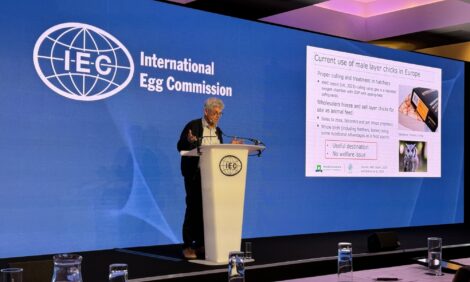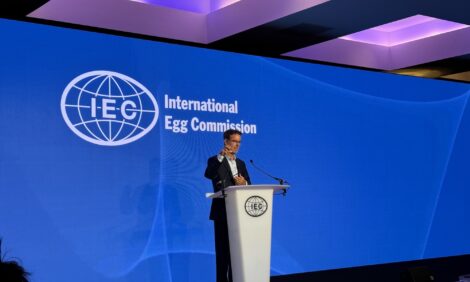



HPAI Impact on Korea's Broiler Meat Industry
Korea's poultry industry has weathered a series of highly pathogenic avian influenza (HPAI) outbreaks over the last several months with no noticeable impact on the country's broiler meat production, according to SunYoung Choi and Michael G. Francom in the latest GAIN report from the USDA Foreign Agricultural Service.Highlights
Korea’s poultry industry has weathered a series of highly pathogenic avian influenza outbreaks over the last several months with no noticeable impact on the country’s broiler meat production. Meanwhile, consumption has actually increased due to a shortage of local pork, high red meat prices and fears about radiation-contaminated seafood from Japan. As a result, this year’s import estimate was raised 22 per cent to 110,000 tons. In response to high prices, the government has announced its intent to open a zero duty tariff-rate quota (TRQ) for chicken but exact details have not yet been revealed.
General Information
On 12 December 2010, the Ministry of Food, Agriculture, Forestry and Fisheries (MIFAFF) notified the World Animal Health Organisation (OIE) of a case of H5N1 highly pathogenic avian influenza (HPAI) in wild birds located in the southern part of the country. The virus quickly spread, affecting commercial duck and chicken operations in 52 farms in six provinces. The last case was reported on 18 April. Poultry on the affected farms has been culled and those premises within a 500-metre radius were also depopulated as a pre-emptive measure. There are no reported human cases.
As of 25 April 2011, the number of culled poultry has reached a record of 6.4 million birds. Nonetheless, local broiler meat (chicken) production and consumption is expected to remain relatively unchanged from earlier estimates since the scope of the outbreak is relatively small in terms of total inventories. In addition, the affected broiler growers are expected to quickly re-populate their flocks. The largest HPAI outbreak before this latest string of cases was in spring 2008 when 3.45 millions of poultry were culled.
Production
As of 25 April, there had been less than one million broilers culled, or about one per cent of total broiler inventories. The impact of these outbreaks on the country’s broiler meat production is expected to be very minor. The local industry anticipates that inventories will gradually stabilise as affected farms re-stock after cleaning and disinfection procedures, which generally take about 30 days. While HPAI was spreading, colder than usual winter weather resulted in marginally lower productivity gains, though this is not expected to have any lasting effect on this year’s total production.
The slight drop in production resulting from HPAI outbreaks and cold weather along with increased demand for chicken due to local pork meat shortages stemming from the country’s FMD crisis, have put upward pressure on live broiler farm gate prices as can be seen in the price series at the end of the report. For example, in early December just before the HPAI outbreaks really took off, the average farm gate price for live broilers was 1,780 won (KRW; US$1.65) per kilo but has since climbed 51 per cent to nearly KRW2,680 ($2.50) per kilo. Higher live bird prices have translated into stronger retail chicken prices, which will be covered in the consumption section of the report. It’s still too early to tell whether higher farm gate prices might spur increased local broiler meat production next year.
Meanwhile, close to three per cent, or about 1.9 million table egg layers have been culled. The table at the end of the report contains details on the number of birds culled by species.
Consumption
Korean consumers are not cutting back on chicken consumption because of the recent spate of HPAI cases in large part because they have already lived through past outbreaks and are well aware that proper handling and cooking eliminate the already low risk of contamination.
Average monthly retail chicken prices, as shown in the table below, have increased compared to the previous year due to several factors including: increased demand for chicken because of the shortage of pork resulting from the earlier FMD crisis; culling of poultry to stem the spread of the HPAI outbreaks; and lower productivity during the unusually cold winter. Prices in April are up nearly 12 per cent compared to the same month last year while the cost of chicken from January-April has climbed 25 per cent.

The switch from pork to chicken is a break from past consumption trends where beef and pork were considered as closer substitutes. However, this paradigm has partly been turned on its head in large part because of high red meat prices and fears over eating fishery products because of radiation fears stemming from the nuclear crisis in Japan. The following graph shows the price trends and differentials between domestically produced chicken and pork.

Note: Hanwoo: 3rd grade Tenderloin / Pork: medium grade pork belly / Broiler: medium grade
Exchange Rate: KRW1,072 = US$1 as of 29 April
Trade
The Korean government announced its decision to open a 50,000 ton duty-free TRQ for broiler meat to stabilise surging retail chicken prices. The details, however, are not yet available. This decision follows earlier announcements for duty free quotas for certain pork cuts and dairy products, which are intended to help minimize rising food inflation.
Korea’s official import estimate for US broiler meat, which USDA released in April, was raised roughly 20 per cent to 110,000 tons to reflect the strong demand. See official estimates below. According to local trade statistics from January-March, chicken imports are up 38 per cent compared with the same period the previous year. Most of the increase is attributed to US chicken sales, which climbed to nearly 20,000 tons during this period, an increase of 118 per cent. Meanwhile, imports of Brazilian chicken fell 33 per cent to 6,700 tons from January-March reportedly because of stronger demand from Japan.
Further Reading
| - | You can view the full report by clicking here. |
May 2011











